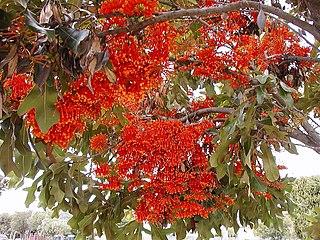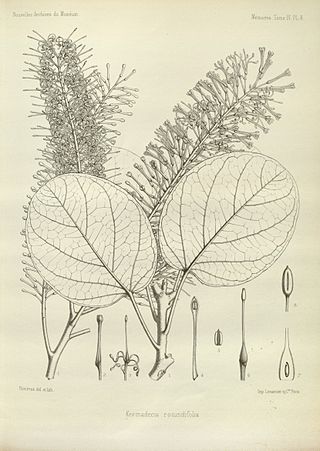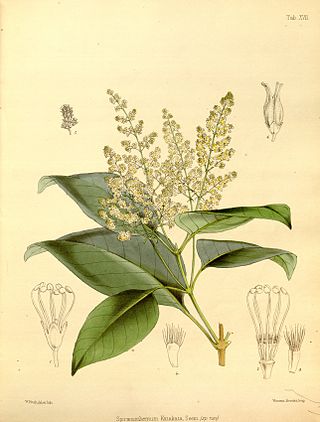
The biodiversity of New Caledonia is of exceptional biological and paleoecological interest. It is frequently referred to as a biodiversity hotspot. The country is a large South Pacific archipelago with a total land area of more than 18,000 square kilometres (6,900 sq mi). The terrain includes a variety of reefs, atolls, small islands, and a variety of topographical and edaphic regions on the largest island, all of which promote the development of unusually concentrated biodiversity. The region's climate is oceanic and tropical.

Stenocarpus is a genus of about 22 species of flowering plants in the family Proteaceae. They are trees or shrubs with variably-shaped leaves, zygomorphic, bisexual flowers, the floral tube opening on the lower side before separating into four parts, followed by fruit that is usually a narrow oblong or cylindrical follicle.

Elattostachys is a genus of about 21 species of trees known to science, constituting part of the plant family Sapindaceae.

Geissois imthurnii is a species of forest tree belonging to the plant family Cunoniaceae. It is endemic to Fiji.
Geissois superba is a species of forest trees, constituting part of the plant family Cunoniaceae. They are endemic to Fiji.

Kermadecia is a genus of flowering plants in the family Proteaceae. The genus comprises eight species of rainforest trees from New Caledonia, Fiji, and Vanuatu. Its closest relative is Euplassa from South America.

Pancheria is a genus of shrubs and trees in the family Cunoniaceae. It is to endemic to New Caledonia and contains 27 species. Leaves or whorled, simple or pinnate. The flowers are arranged in capitula, fruits are follicular. The species are dioecious. The genus is well diversified on ultramafic rocks and some species are nickel hyperaccumulators. It is related to Cunonia and Pterophylla. It was named after Jean Armand Isidore Pancher.

Spiraeanthemum is a genus of trees and shrubs in the family Cunoniaceae. it includes about 19 species from Australia, New Guinea, Solomon Islands, New Caledonia, Vanuatu, Fiji and Samoa. Leaves are simple, opposite or whorled, with toothed or entire margins. Inflorescences are paniculate, flowers unisexual or hermaphrodite, and the fruits are follicular with free carpels. It belongs to the tribe Spiraeanthemeae, and now includes the species formerly placed in Acsmithia.

Cunonia is a genus of shrubs and trees in the family Cunoniaceae. The genus has a disjunct distribution, with 24 species endemic to New Caledonia in the Pacific, and one species in Southern Africa. Leaves are opposite, simple or pinnate with a margin entire to serrate. Interpetiolar stipules are often conspicuous and generally enclose buds to form a spoon-like shape. Flowers are bisexual, white, red, or green, arranged in racemes. The fruit is a capsule opening first around the base then vertically, seeds are winged.

Karrabina benthamiana is a species of rainforest trees, growing naturally in north–eastern New South Wales and south–eastern Queensland, Australia. They have common names including red carabeen, leather jacket, brush mahogany, red bean, pink marara and brush mararie. This species used to be placed in the genus Geissois as Geissois benthamiana.

Codia is a genus of trees and shrubs in the family Cunoniaceae. The genus is endemic to New Caledonia in the Pacific and contains 15 species. The leaves are opposite or whorled, simple, and the margin usually entire. The flowers are arranged in capitula. the ovary is inferior. The fruit is indehiscent and is covered with woolly hairs.

Karrabina biagiana is a species of large rainforest trees commonly known as northern brush mahogany, northern brush mararie or red carabeen, in the plant family Cunoniaceae. This species used to be placed in the genus Geissois as Geissois biagiana.

Deplanchea is a genus of about eight species of tropical rainforest trees, constituting part of the plant family Bignoniaceae.

Cossinia is a genus of four species of rainforest trees, constituting part of the plant family Sapindaceae. The genus has a disjunct distribution, occurring in Mascarene Islands, Australia, New Caledonia and Fiji.
Geissois denhamii is a species of forest trees endemic to the island nation of Vanuatu in the Pacific.

Karrabina is a genus of trees in the family Cunoniaceae. It is endemic to eastern Australia and includes two species: Karrabina benthamiana and Karrabina biagiana, previously placed in the genus Geissois.

Gillbeea is a genus of three species of Australasian rainforest trees from the family Cunoniaceae.
Hooglandia ignambiensis is a species of trees in the family Cunoniaceae. It is endemic to New Caledonia and the only species of the genus Hooglandia. It is named after Dutch botanist Ruurd Dirk Hoogland.
Flore de la Nouvelle-Calédonie is an ongoing multi-volume flora describing the vascular plants of New Caledonia in the South-West Pacific. published by the National Museum of Natural History in Paris since 1967. Each species treatment typically includes taxonomic information, morphological description, a line drawing and a distribution map. Originally published as Flore de la Nouvelle-Calédonie et Dépendances, since 2014 it has been renamed shortly Flore de la Nouvelle-Calédonie and is co-published with Institut de Recherche pour le Développement in a fully colored format. Flore de la Nouvelle-Calédonie currently consists of 27 volumes, covering little over 50% of a total of approximately 3,400 species native to the New Caledonian archipelago. Major botanical families awaiting treatment include Rubiaceae, Cyperaceae, Rutaceae, and Poaceae.

Pterophylla is a genus of trees of the family Cunoniaceae, with species found growing naturally in Madagascar, Malesia, Papuasia, and the Pacific Islands, formerly included in Weinmannia.
















